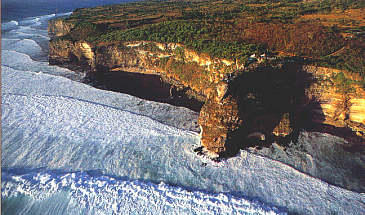 I walked out to the cliff high above the place where the Timor Sea meets the Indian Ocean, and walked down the rocky path to a place in between the warung and the ding repair shop.
I walked out to the cliff high above the place where the Timor Sea meets the Indian Ocean, and walked down the rocky path to a place in between the warung and the ding repair shop. Bali
 I walked out to the cliff high above the place where the Timor Sea meets the Indian Ocean, and walked down the rocky path to a place in between the warung and the ding repair shop.
I walked out to the cliff high above the place where the Timor Sea meets the Indian Ocean, and walked down the rocky path to a place in between the warung and the ding repair shop.
I stood upon Uluwatu's cliff gazing out to the vastness of the ocean, tides of blue and green and white waves. Surrounded by dragonflies whispering their secrets, I gazed at the fishing boats bobbing in the distance, and watched surfers walking out from the cave over the shallow coral reef, then paddling out to the breaks, swaying with the waves, lining up to catch a ride, a big one.
I felt the breeze as it slapped my skirt against my legs, I listened to the voices of the people, I felt their eyes watching me. Who am I, this person standing on the cliff, white skin and strange accent?
I am the dragonfly, whispering my secrets. I am the waves of blue and green and white.

Bali's sky is of the most beautiful hue of blue -- powder blue. Every morning I would wake up and look up to see this color, a color I never particularly favored. But for some reason it now looked strangely perfect, from peak to horizon, with white puffy clouds. Every morning I would wake up and look out into the brown mud of the rice paddies, then later into the greenness of the rice plants, and wonder about how transcendent everything looked next to that powdery blue.
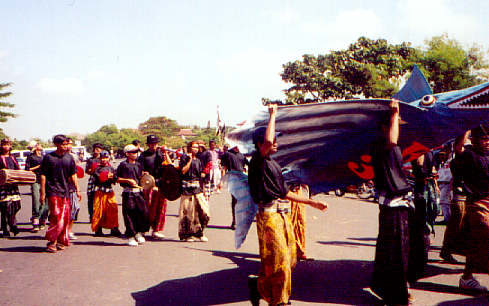 We were lucky to be in Bali during "Kite Season" and for the International Kite Competition. Let me say two things: (1) kites are BIG in Bali, literally and figuratively speaking; and (2) nothing in Bali is done without ceremony. For the competition, groups of Balinese representing different communities from all over the island brought their homemade creations. Many kites were so big that, while waiting for their turn to fly, each group would sit on the ground and put the kite on top of their heads for shade. They were dressed in their fine traditional clothing, and as each group was called to participate, they paraded forward with their kites followed by musicians playing traditional instruments -- drums and cymbals and gongs and bells, and those without English names.
We were lucky to be in Bali during "Kite Season" and for the International Kite Competition. Let me say two things: (1) kites are BIG in Bali, literally and figuratively speaking; and (2) nothing in Bali is done without ceremony. For the competition, groups of Balinese representing different communities from all over the island brought their homemade creations. Many kites were so big that, while waiting for their turn to fly, each group would sit on the ground and put the kite on top of their heads for shade. They were dressed in their fine traditional clothing, and as each group was called to participate, they paraded forward with their kites followed by musicians playing traditional instruments -- drums and cymbals and gongs and bells, and those without English names.
The kites were spectacular, and came in every size and shape. Balinese artistry is prominently displayed in kites fashioned into the shape of things you normally would expect to fly: cranes, eagles, flying fish, butterflies, bats, dragonflies, roosters, and owls. Then there's another category of kites representing imaginary things: the Balinese dragon, a flying bus, what appeared to be some kind of horned devil-man, and miscellaneous flying beasts.
 The competition was fun to sit and watch for a while, but it was also fun to watch the everyday kite flying of the local people. Each day I would marvel at the dozens and dozens of kites drifting overhead, and watch the young kids running up and down the streets trying to get their little hand-made kites up into the air. It was a scrumptious way to enjoy that beautiful, powder-blue sky.
The competition was fun to sit and watch for a while, but it was also fun to watch the everyday kite flying of the local people. Each day I would marvel at the dozens and dozens of kites drifting overhead, and watch the young kids running up and down the streets trying to get their little hand-made kites up into the air. It was a scrumptious way to enjoy that beautiful, powder-blue sky.
Bali is a small island possessing all those wonderful island-like things: beautiful beaches, volcanoes with a hazy and faraway feel, shrouded in misty clouds; urban tourist centers and village after village after village, each with their own character. We traveled around much of the island, but stayed mainly in two places: Kuta Beach and Ubud, an artistic center lying more towards the center of the island.
Kuta, love it or hate it, is a sizeable stretch of beach lined with shops and stores and restaurants and nightclubs, and lots and lots of tourists. It's much easier to walk than it is to drive, and we navigated the area by using "gangs," or small footpaths that wound maze-like through the neighborhoods. Gangs are lined with high cement walls outlining the perimeter of family compounds, and are quiet spaces covered with beautiful trees and flowering plants. Starry nights were especially fun since no lights marked the path -- the night sky was unobscured. The beaches in Kuta (as in other parts of Bali) are spectacular, with high waves supporting world-class surfing and world-class sunsets. The shopping was pretty good, too.
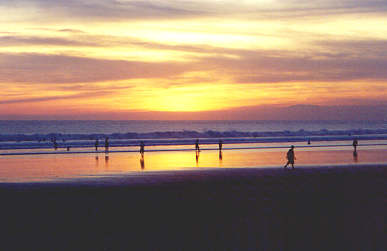
Ubud is an artistic center of Bali, with a high degree of culture provided in the way of dance, music, painting, jewelry, and wood- and stone-working. The architecture was fascinating: many of the places to stay for visitors were in the Balinese-style family compounds designed of granite, terracotta, and wood, and the rich jewel tones of paint and ink splashed everywhere.
 The spiritual aspect of the Balinese lifestyle was evident everywhere: in the Hindu temples located in each compound, and in the daily ritual offerings located at every entryway to every building. Offerings were simple to elaborate, ranging from a small square of leaf with a few grains of rice and small flower petals to the more elaborate square "dish" made out of leaf filled with rice, whole flowers, decorated with cut and shaped leaves, with burning incense sticking out of edge. Women dressed in lace blouses and batik skirts carried their trays of offerings on their heads, elaborately dipping flowers into water made holy and flicking the petals about them.
The spiritual aspect of the Balinese lifestyle was evident everywhere: in the Hindu temples located in each compound, and in the daily ritual offerings located at every entryway to every building. Offerings were simple to elaborate, ranging from a small square of leaf with a few grains of rice and small flower petals to the more elaborate square "dish" made out of leaf filled with rice, whole flowers, decorated with cut and shaped leaves, with burning incense sticking out of edge. Women dressed in lace blouses and batik skirts carried their trays of offerings on their heads, elaborately dipping flowers into water made holy and flicking the petals about them.
We happened across a bungalow on a back road of a hill just above town where we stayed for a combined three weeks. It was a small place -- five bungalows sitting right on the edge of one family's rice paddy field, peaceful and secluded, each bungalow self-contained in its own building and separated by rows of plants and trees. It was a no frills place -- cold water shower and temperamental electricity, but it was about as inexpensive as you can get -- $4.50 per night for three people, and that included breakfast and hot tea throughout the day! Each morning Ketut, the manager of the bungalows, would shuffle down with a tray of food: each of us got a bowl of fresh fruit, coffee or tea, and either a fruit jaffle (two slices of bread stuffed with bananas and grilled), or a green coconut banana pancake. One day we asked what made the pancakes green; Ketut told us that he would go out and pick leaves from a special plant, soak the leaves in water and then rub them together, coloring the water green. After we would leave for the day, he would remove the dirty dishes and replace them with a thermos bottle full of tea and clean cups. It was a special place for us, there in our little bungalow.


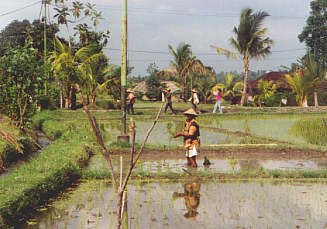
It was a wonderful experience, too, hanging out near the rice paddies -- we were literally about two feet off from the field, and each day we watched the people work the fields and plant new rice plants. Each paddy is a different shape and on different levels, allowing water to flow from one into the next. When the fields are empty herds of ducks come to play in the water and mud, and bats and frogs and fireflies are plentiful after dark. After the fields are planted, little birds taunt the workers by snacking on the goodies planted in the earth. This provoked the people into constructing poles with fabric tied on to them, or ropes strung across the fields with dangling fabric strips, so that when the wind blows they act as scarecrows to keep the birds out.
Dogs run along the narrow paths in between each field, and men and women carrying baskets full of seedling rice plants work tirelessly, slogging through the mud in rhythmic motions, regulating the water flow, patching mud walls, hoping Dewi Sri, the Rice Goddess, will bring fortune to their crops.
And just to prove that your dreams really do come true, during our stay in Ubud I fulfilled a long-time dream of mine, that of learning to batik from the Balinese.
It may be said that batik is an art form which developed in Java, specifically Central Java. This statement pertains to the method of batiking; the ornamentation itself developed as a harmonization of various influences exerted by other cultures. What is Batik? Batik is a drawing or a painting or a form of writing on cotton cloth, applied with the aid of a tool called tjanting. Drawing or painting or writing onto the cotton cloth by an artist of artisan is termed … batiking." Classical Batik, |
I saw the sign outside the family home: "Batik Sekar Bali -- Batik Workshop", and stepped on through the stone entryway. It was like going back home. |
| Walking into the open courtyard area, I could tell there were lots of different things going on. Off to the left were three women sitting at sewing machines, quilting finished pieces of batik into bedspreads. Each stopped to smile and wave, then continued buzzing along on the machines. Several family members passing from one building to another stopped to say hello, and one of the daughters, named Putu, welcomed me in and asked what I would like to do that day. "Pillow cover? T-Shirt? Bedspread?" she asked. "I think I'll stick to a practice piece right now," I answered, "and may I use one of your designs?" She left to go find her designs, and I looked around some more. | |
| Four generations of their family lived within the compound. "Grandma", who is 98 years old, sat on a chair in the middle of the courtyard to watch the goings-on. The youngest member of the family is a new baby, 3 months old. Anyone who passes by either Grandma or the baby stopped to talk or coo or feed, or get whatever they wanted or needed. "Mother" (Ni Made Warthini, creator and leader of the workshop) stopped by and asked if I would like any tea, which she prepared with ginger and lemon in the outdoor kitchen, a little farther back in the compound. | |
Putu came out with her designs; I chose a flower design for my first lesson, and a fish design my second. She helped set everything up at the tracing table, where I copied the design in pencil onto a small piece of cotton. When that was completed, she led me to the area in the back of the compound where several women were up on a platform, sitting around a bowl of wax on a bunsen burner type warming dish. She gave me a hand-made tjanting, the tool used to pour melted wax onto the design I penciled in. I sat with four other women around the small pot of wax, sitting closely so that all of us could reach the pot of wax. I was a little nervous handling the new tool and the hot wax, but I kept trying, dividing my attention between the batik design and listening to the women talk to each other in Balinese, singing, and softly giggling. Once in a while they would look at my work, then discuss it, and either correct or help me, or say "bagus" (Baliness for "good"). "Mother" later told me that, in addition to her family, she invited other young women to come learn the batik craft. She taught them and gave them a place to work. During another of my waxing sessions I was learning another technique, that of applying a different kind of wax to large areas of the fabric. I was given my own pot of wax down on the floor. As I sat working with the different technique, I listened to the chickens chattering around the open compound, and the rooster, sitting in a bamboo cage about 2 feet away, cock-a-doodle-doing. The wax warmer next to me popped and crackled, and I wondered if it was going to start on fire the cardboard box it was sitting in. Since Putu stepped away and none of the other ladies spoke English, I had to trust that it would be okay (and it was). | |
 | 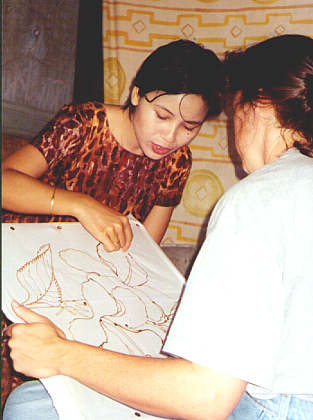 |
After I finished applying wax to the design it was checked over by the other women. They helped clean up my mistakes and pointed out areas that needed a little more wax. When this section was complete, I was led over to the painting table. My fabric was pinned on top of a piece of burlap on the table, and after deciding which colors I wanted to use, I started to paint the design. Using homemade bamboo brushes and regular hair brushes, I cautiously applied the paint. Everyone once in a while I would hear "No! Not good technique!" from one woman who knew little English but who knew enough to make me stop very quickly. Her advice was very good, and Putu later told me she was the resident "expert." And occasionally "Mother" would stop by to check my progress and offer words of encouragement. Putu would sit at the side of the table, nursing her baby, and I could hear "Grandma" shouting at a stray dog as it passed by. After I finished painting, my piece of fabric was spread out on the ground to dry in the sun, and broken ceramic tile pieces were place on the corners to hold the fabric down. When it dried, a male member of the family was called in. He dipped the entire piece in a bucket containing dye for the background. After all the dying was done, he dipped the fabric, using a big stick, it in another bucket containing chemicals that fixed the colors, and then in another bucket with hot water and laundry detergent to remove the wax. The fabric was then hung up to dry on the clothesline, where we would all stand to see how it looked. No matter how it turned out, I was delighted and could barely contain my giggles and excitement. | |
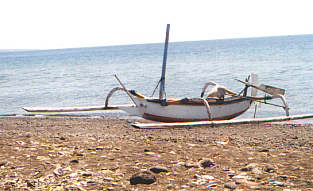 Bali was full of many, many other adventures and misadventures -- too many to tell in this newsletter. But I can say that this island was full of mystery and beauty, and an odd mixture of ancient spiritualism and modern interactions with foreigners. There were times that we couldn't bear to be picked on or ripped off any more, especially by the smiling, beautiful Indonesians. And there were times that I felt lost, after all this traveling, lost in images melting together in an abstract way.
Bali was full of many, many other adventures and misadventures -- too many to tell in this newsletter. But I can say that this island was full of mystery and beauty, and an odd mixture of ancient spiritualism and modern interactions with foreigners. There were times that we couldn't bear to be picked on or ripped off any more, especially by the smiling, beautiful Indonesians. And there were times that I felt lost, after all this traveling, lost in images melting together in an abstract way.
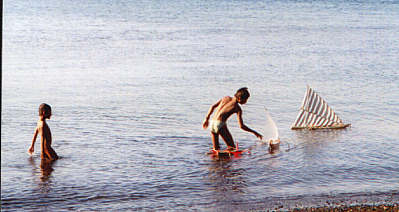 One day, while searching for a remote beach recommended by a local for snorkeling (you get to by turning onto the only main street that crosses the road after you pass through a village called "Bugbug") we came across a rather strange thing. There amongst the lush tropical foliage was a billboard (the only billboard around) for Marlboro cigarettes, the Marlboro Man in full cowboy regalia. It looked so strange, this mix of East and West, a cowboy in the tropics. The coral reef, however, was fabulous ... and the children were serene.
One day, while searching for a remote beach recommended by a local for snorkeling (you get to by turning onto the only main street that crosses the road after you pass through a village called "Bugbug") we came across a rather strange thing. There amongst the lush tropical foliage was a billboard (the only billboard around) for Marlboro cigarettes, the Marlboro Man in full cowboy regalia. It looked so strange, this mix of East and West, a cowboy in the tropics. The coral reef, however, was fabulous ... and the children were serene.
| Pictures of Bali |